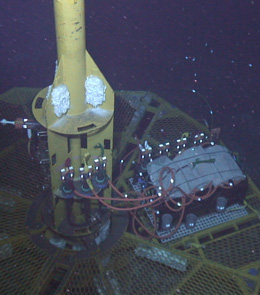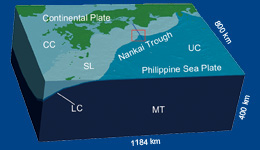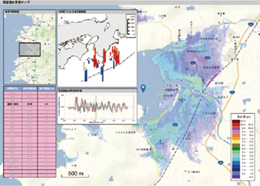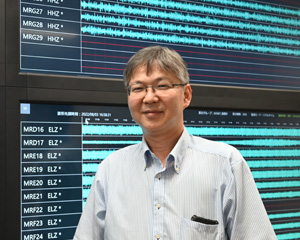Research and Development Center for Earthquake and Tsunami Forecasting (FEAT)
Continuous Seafloor Crustal Deformation Monitoring and Earthquake/Tsunami Forecasts
Most of the rupture areas of huge earthquakes with magnitudes of over 8 extend beneath the seafloor. The mission of our center is to develop technologies for real-time monitoring of crustal and seawater movements on the seafloor, and to make maximum use of these observation data to develop and implement a system for forecasting earthquakes and tsunamis. Our goal is to understand crustal deformation during the pre-, co-, and post-seismic periods, as well as tsunami and other phenomena that occur as a result of earthquakes, seafloor landslides, and so on.
- 2025/07/03
- Recruitment of Postdoctoral Researcher (CGP25-004)
- 2025/04/25
- Observation of a remote island volcano by an unmanned helicopter taking off from a research vessel and operated remotely via satellite communications (flash report)
- 2025/02/26
- Researcher Ychen Wang receives the Kamide Lecture Award
- 2024/05/31
- Recognized as Top Cited Article
- 2024/05/09
- Earthquake Forecasting Research Group, Recruitment of a Postdoctoral Researcher (CGP24-003)
- 2024/04/26
- Earthquake and Tsunami Monitoring Group, Recruitment of a Researcher or Researcher (II) (CKS24-001)
- 2023/10/20
- Multiple positions as Postdoctoral Researchers (CGP23-008)
- 2023/05/24
- Earthquake and Tsunami Monitoring Group, Recruitment of a Postdoctoral Researcher (CGP23-004)
- 2023/02/02
- Earthquake and Tsunami Monitoring Group, Recruitment of a Postdoctoral Researcher (CGP22-005)
- 2023/02/01
- Data assimilation using high-frequency radar for tsunami early warning: A case study of the 2022 Tonga volcanic tsunami
- 2022/10/19
- Earthquake Forecasting Research Group, Recruitment of a Researcher, Researcher (Ⅱ) or Postdoctoral Researcher (CKM22-004)
- 2021/11/19
- Recruitment of Postdoctoral Researcher (CGP21-006)
- 2021/10/05
- Recruitment of Postdoctoral Researcher (CGP21-005)
- 2021/09/30
- Recruitment of Researcher (Ⅱ) (CKS21-004)
- 2021/06/10
- Recruitment of Postdoctoral Researcher CGP21-003
- 2020/10/08
- JAMSTEC is recruiting one position as a Postdoctoral Researcher CGP20-003
- 2020/07/16
- A website of Program for Promoting Researches on the Supercomputer Fugaku, "Large-scale numerical simulation of earthquake generation, wave propagation and soil amplification" has been launched.
- 2020/06/08
- FY2020 Recruitment of Postdoctoral Researcher CGP20-003
- 2020/05/25
- FY2020 Earthquake and Tsunami Monitoring Group, Recruitment of Postdoctoral Researcher CGP20-002
- 2019/11/18
- FY2020 Earthquake Forecasting Research Group, Recruitment of Senior Scientist or Senior Technical Scientist (CKS-006)
- 2019/11/13
- FY2020 Earthquake Forecasting Research Group Recruitment of Scientist or Technical Scientist (CKS-005)
- 2019/06/07
- Research and Development Center for Earthquake and Tsunami Forecasting (FEAT) website has been launched.
Continuous Real-Time Monitoring of Seafloor Crustal Deformations
 Seafloor observatory at a borehole constructed by using CHIKYU
Seafloor observatory at a borehole constructed by using CHIKYU
The Research and Development Center for Earthquake and Tsunami Forecasting (FEAT) is developing a continuous real-time wide-area monitoring system for seafloor crustal deformations around the Nankai Trough in order to predict earthquakes and tsunamis.
JAMSTEC installed seismographs and water-pressure gauges at 51 sites on the seafloor around the rupture areas of the Nankai and Tonankai Earthquakes. These are then connected to the land stations via seafloor cables for conducting continuous real-time earthquake and tsunami monitoring with the “Dense Oceanfloor Network System for Earthquakes and Tsunamis (DONET)※1.
Borehole measurements are effective to monitor the seafloor crustal deformation at a higher precision. JAMSTEC has been conducting drilling studies offshore of Kii Peninsula using the Deep-sea Scientific Drilling Vessel CHIKYU to install these systems. Currently, 3 long-term borehole monitoring systems have been installed in boreholes several hundred meters below the seafloor and continuous real-time crustal deformation monitoring is achieved by connecting with DONET. In the near future, we plan to install similar observation systems in boreholes several hundred meters below the seafloor at 3 sites in the area west of the Kii-Channel, which will be connected to the seafloor cable observation systems, such as DONET, using CHIKYU.
In addition, we have been using the Research Vessel KAIMEI’s Giant Piston Corer to drill boreholes ~20m below the seafloor for installing seafloor crustal deformation observation equipment and laying the optical fibers for broadband observation of strain on the earth’s crust.
We are expanding our continuous real-time crustal deformation observation network by connecting these equipment to the DONET.
※1:Now the DONET is managed by the National Research Institute for Earth Science and Disaster Resilience.
Near-future Predictions of the state of Seismogenic Zone
 A finite element model reflecting heterogeneous underground structure
A finite element model reflecting heterogeneous underground structureConventional earthquake cycle simulations to reproduce the occurrence intervals and patterns of earthquakes utilized simple subsurface structure model. In the future, we aim to understand the current state of the seismogenic zone and predict near-future conditions by utilizing both subsurface structural survey data and seafloor crustal deformation data.
By analyzing seafloor and terrestrial crustal deformation data with the models that reflect subsurface structure and physical property estimated by the Subduction Dynamics Research Center, we aim to comprehend the current conditions of fault locking/slipping, estimate the stress distribution on the fault and fault strength, and predict near-future fault locking/slipping behavior. On the shallow and deep plate interface in the Nankai Trough, “slow slips” of several centimeters/week to tens of centimeters/month occur. We focus on the slow slips because they will inform us of the change in the potential for the generation of a large earthquake. Although slow slips are not unusual, some remarkable situations where the area of slow slips overlaps the source areas of the large earthquakes, or the area continually expands after M6-7 earthquakes, can occur. In these unusual situations, the possibility of a huge earthquake is thought to be higher than normal. Thus, we aim to detect unusual locking/slipping conditions by collecting data from seafloor crustal deformation monitoring systems. It is known that huge earthquakes occurred successively along the Nankai Trough, for instance, the Nankai earthquakes that occurred 1.5 days and two years after the Tokai and Tonankai earthquakes. Once a large earthquake occurs, we will estimate the unruptured area and will predict the size and rupture area of the forthcoming earthquake and associated tsunami. Moreover, after the first earthquake, the slow slip area expands into its surroundings, leading to successive earthquakes. We advance research and development to monitor and predict these slow slips and to provide information regarding future earthquakes.
A Tsunami Prediction System that takes Storm Surges and Submarine Landslides into Account
 Real-time tsunami forecasting system based on the seafloor pressure monitoring.
Real-time tsunami forecasting system based on the seafloor pressure monitoring.Forecasts of tsunami arrival time, wave height, inundation depth and inundation area in the targeted area is updated every second.
JAMSTEC has built a real-time tsunami forecasting system using DONET, and this system has already been introduced in Wakayama, Mie, and Kagawa prefectures, Chubu Electric Power Co., Inc, and Kagawa University, in collaboration with the National Research Institute for Earth Science and Disaster Prevention, which is managing the DONET. The real-time tsunami forecasting system uses observed offshore water pressure data from DONET, as well as coastal tsunami height and the timing and breadth of flooding, to transmit real-time information that is useful for disaster prevention. However, DONET water pressure gauge readings are not only high during tsunamis but also during storm surges due to typhoons. Like earthquakes, submarine landslides in a comparatively small area have been known to cause large tsunamis. Thus, we are continuing to improve the real-time tsunami forecasting system by distinguishing between storm surges and tsunamis, as well as improving our ability to predict tsunamis induced by landslides.

Takane Hori
Director of Center
Specialty: Earthquake Forecasting
We have been developing a system to comprehend the past and present occurrences of phenomena that cause earthquakes to be able to forecast future events. When an earthquake occurs in the future, I hope that people will say, "I knew it will happen there, and I am glad we prepared for it in advance.”